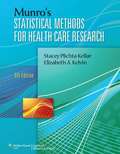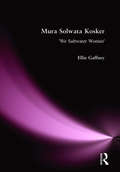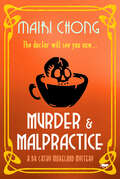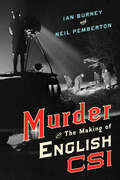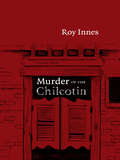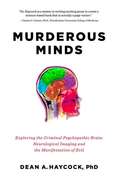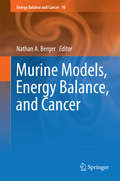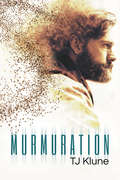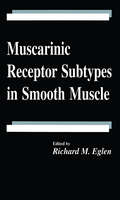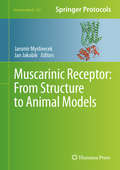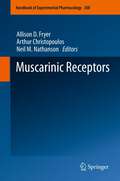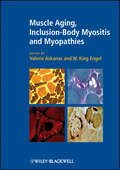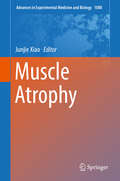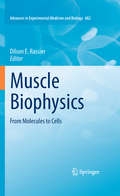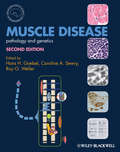- Table View
- List View
Mund-, Kiefer- und Gesichtschirurgie: Operationslehre und -atlas
by Harald Eufinger Alexander Kübler Henning SchliephakeIn dem Band sind alle Eingriffe der Mund-, Kiefer- und Gesichtschirurgie detailliert beschrieben und in über 1000 Zeichnungen illustriert. Darüber hinaus geben Experten der MKG-Chirurgie Tipps für die Anwendung im OP-Saal. Dargestellt werden Implantologie, septische Chirurgie, Traumatologie des Kiefer- und Gesichtsbereichs sowie die Behandlung der Lippen-Kiefer-Gaumenspalten und die Chirurgie des Gesichtsschädels, die Tumorchirurgie inklusive der plastisch rekonstruktiven Chirurgie und der modernen Verfahren des mikrovaskulären Gewebetransfers.
Munro's Statistical Methods for Health Care Research
by Stacey Plichta Elizabeth Kelvin Stacey Kellar MunroThis text provides students with a solid foundation for understanding data analysis and specific statistical techniques. Focusing on the most current and frequently used statistical methods in today's health care literature, the book covers essential material for a variety of program levels including in-depth courses beyond the basic statistics course. Well-organized, clear text discussions and great learning tools help students overcome the complexities and fully comprehend the concepts of this often intimidating area of study.
Mura Solwata Kosker: We Saltwater Women
by Ellie GaffneyThroughout her lifetime, Ellie Gaffney has been a strong advocate both within Australia and internationally of the interests and welfare of Torres Strait Islanders. She has been particularly committed to advancing the rights of Indigenous women. Her interests have spanned a wide spectrum of concerns. As an administrator, Ellie Gaffney played a significant part in the development of hostel accommodation and primary health care for all Torres Strait Islanders. Ellie's work in establishing the Mura Kosker Sorority as a platform for change is widely recognised. At all times she has been an eloquent and determined presenter of the real situation of Torres Strait Islanders. In recognition of her contribution to the Torres Strait and its people, Ellie was appointed a Member of the General Division of the Order of Australia (AM) in the Queen's Birthday Honours List. This memoir covers the period since the publication of her first book Somebody Now some twenty fours years ago. In doing so she shares with us and future generations her personal journey, a task she has undertaken at a time of failing health. It is a fitting reminder of the work and stature of a dedicated woman. Readers of this manuscript will be inspired by Ellie Gaffney's efforts on behalf of Torres Strait Islanders and all Indigenous people.
Murder & Malpractice (The Dr. Cathy Moreland Mysteries)
by Mairi ChongA doctor&’s office is plagued with deaths from unnatural causes in this &“fabulous start to a murder mystery series . . . well plotted story and great characters&” (Peter Boon, author of Who Killed Miss Finch?). Dr. Cathy Moreland has recently returned to work after battling mental health challenges, but her surgery in the British countryside is simmering, as usual, with tensions. One doctor struggles to keep up with the changes in the medical field; another, ambitious and aggressive, is romantically entangled with a nurse. The newest arrival, a pharmacist, seems very competent—but his behaviour is mysterious. When one of the doctors dies after drinking a cup of coffee, the practice is thrown into a state of suspicion and chaos. Circumstances seem to point toward one partner—but Cathy intends to examine the evidence more closely . . .
Murder By The Book: The Eighteenth Chronicle of Matthew Bartholomew (Chronicles of Matthew Bartholomew #18)
by Susanna GregoryThe eighteenth chronicle in the Matthew Bartholomew series. It is drawing near to the end of term, and the University at Cambridge is in turmoil over the opening of a new Common Library. There is an attack on one of the masters at a meeting to discuss the matter, and a body is found floating in the pond in the library's garden on the eve of its opening. Meanwhile, there are rumours of a large force of dangerous smugglers lurking in the Fens. Aided by their friend Sheriff Tulyet, Bartholomew and Michael must thwart the invaders before the Feast of Corpus Christi the following week. To fail might mean the destruction of the town...'A first-rate treat for mystery lovers' (Historical Novels Review)'Susanna Gregory has an extraordinary ability to conjure up a strong sense of time and place' (Choice)
Murder By The Book: The Eighteenth Chronicle of Matthew Bartholomew (Chronicles of Matthew Bartholomew #18)
by Susanna GregoryIt is drawing near to the end of term, and the University at Cambridge is in turmoil over the opening of a new Common Library. There is an attack on one of the masters at a meeting to discuss the matter, and a body is found floating in the pond in the library's garden on the eve of its opening. Meanwhile, there are rumours of a large force of dangerous smugglers lurking in the Fens. Aided by their friend Sheriff Tulyet, Bartholomew and Michael must thwart the invaders before the Feast of Corpus Christi the following week. To fail might mean the destruction of the town...
Murder Isn't Easy: The Forensics of Agatha Christie
by Carla ValentineFascinating - PrimaAgatha Christie is one of our most beloved authors - a storyteller unparalleled in her clever plots and twisting tales. But Agatha was also a forensic expert; in each of her books she employs an expert weaving of human observation, ingenuity and genuine science of the era.In Murder Isn't Easy Carla Valentine illuminates all of Agatha's incredible knowledge, showing how she stayed at the cutting edge of forensics from ballistics to fingerprint analysis, as seen through much-loved characters such as Poirot and Miss Marple.From the glamour and grit of Agatha Christie's stories, to the real-life cases that inspired them, Murder Isn't Easy will immerse you in the forensics that influenced generations of writers and scientists alike.
Murder Isn't Easy: The Forensics of Agatha Christie
by Carla ValentineFascinating - PrimaEngaging and informative - GuardianAgatha Christie is one of our most beloved authors - a storyteller unparalleled in her clever plots and twisting tales. But Agatha was also a forensic expert; in each of her books she employs an expert weaving of human observation, ingenuity and genuine science of the era.In Murder Isn't Easy Carla Valentine illuminates all of Agatha's incredible knowledge, showing how she stayed at the cutting edge of forensics from ballistics to fingerprint analysis, as seen through much-loved characters such as Poirot and Miss Marple.From the glamour and grit of Agatha Christie's stories, to the real-life cases that inspired them, Murder Isn't Easy will immerse you in the forensics that influenced generations of writers and scientists alike.
Murder and Madness on Trial: A Tale of True Crime from Early Modern Bologna (Interactions in the Early Modern Age)
by Mònica CalabrittoOn October 24, 1588, Paolo Barbieri murdered his wife, Isabella Caccianemici, stabbing her to death with his sword. Later, Paolo would claim to have acted in a fit of madness—but was he criminally insane or merely pretending to be? In this riveting book, Mònica Calabritto addresses this controversy by reconstructing Paolo’s life, prosecution, and medical diagnoses.Skillfully combining archival documents unearthed throughout Italy, Calabritto brings to light the case of one person and his family as insanity ravaged their financial security, honor, and reputation. The very notion of insanity is as much on trial in Paolo’s case as the defendant himself. A case study in the diagnosis of insanity in the early modern era, Barbieri’s story reveals discrepancies between medical and legal definitions of a person’s mental state at the time of a crime. Murder and Madness on Trial bridges the micro-historical dimensions of Paolo’s murder case and the macro-historical perspectives on medical and legal evidence used to identify intermittent madness.A tragic and gripping tale, Murder and Madness on Trial allows readers to look “through a glass darkly” at early modern violence, madness, criminal justice, medical and legal expertise, and the construction and circulation of news. This erudite and engaging book will appeal to early modern historians and true crime fans alike.
Murder and the Making of English CSI
by Ian Burney Neil PembertonThe engrossing account of how science-based forensics transformed the investigation of twentieth-century murders and in the process invented CSI.Crime scene investigation—or CSI—has captured the modern imagination. On television screens and in newspapers, we follow the exploits of forensic officers wearing protective suits and working behind police tape to identify and secure physical evidence for laboratory analysis. But where did this ensemble of investigative specialists and scientific techniques come from? In Murder and the Making of English CSI, Ian Burney and Neil Pemberton tell the engrossing history of how, in the first half of the twentieth century, novel routines, regulations, and techniques—from chain-of-custody procedures to the analysis of hair, blood, and fiber—fundamentally transformed the processing of murder scenes. Focusing on two iconic English investigations—the 1924 case of Emily Kaye, who was beaten and dismembered by her lover at a lonely beachfront holiday cottage, and the 1953 investigation into John Christie’s serial murders in his dingy terraced home in London’s West End—Burney and Pemberton chart the emergence of the crime scene as a new space of forensic activity. Drawing on fascinating source material ranging from how-to investigator handbooks and detective novels to crime journalism, police case reports, and courtroom transcripts, the book shows readers how, over time, the focus of murder inquiries shifted from a primarily medical and autopsy-based interest in the victim’s body to one dominated by laboratory technicians laboring over minute trace evidence. Murder and the Making of English CSI reveals the compelling and untold story of how one of the most iconic features of our present-day forensic landscape came into being. It is a must-read for forensic scientists, historians, and true crime devotees alike.
Murder by Degrees: A Mystery
by Ritu MukerjiFor fans of Jacqueline Winspear and Charles Todd, Murder by Degrees is a historical mystery set in 19th-century Philadelphia, following a pioneering woman doctor as she investigates the disappearance of a young patient who is presumed dead.Philadelphia, 1875: It is the start of term at Woman&’s Medical College of Pennsylvania. Dr. Lydia Weston, professor and anatomist, is immersed in teaching her students in the lecture hall and hospital. When the body of a patient, Anna Ward, is dredged out of the Schuylkill River, the young chambermaid&’s death is deemed a suicide. But Lydia is suspicious and she is soon brought into the police investigation. Aided by a diary filled with cryptic passages of poetry, Lydia discovers more about the young woman she thought she knew. Through her skill at the autopsy table and her clinical acumen, Lydia draws nearer the truth. Soon a terrible secret, long hidden, will be revealed. But Lydia must act quickly, before she becomes the next target of those who wished to silence Anna.
Murder by an Aristocrat (The\sarah Keate Mysteries Ser. #5)
by Mignon G EberhartAn aristocratic family hiding secrets - and murder.Classic crime from 'One of American's favourite writers' Mary Higgins Clark'Suspense to the very end' NEW YORK TIMESNurse Sarah Keate is no stranger to mystery - she has solved conspiracies and murders in places as varied as her once-sleepy hospital ward, a gothic mansion, and the Sand Hills of Nebraska. But the Thatchers are different. As close to aristocracy as an American family can get, one of their own requires Keate's care for a suspicious bullet wound to his right shoulder. A wound a relative insists was self-inflicted ...When the victim dies under even stranger circumstances, Keate knows that he was murdered. As the family closes ranks and struggles to keep its darkest secrets buried, Nurse Keate will stop at nothing to find the truth - but at what cost?
Murder in the Chilcotin (Inspector Coswell of the RCMP #3)
by Roy InnesThe third book in Roy Innes' mystery series sends RCMP Inspector Coswell and the newly promoted Sergeant Blakemore to the rugged district of West Cariboo in British Columbia, where a young Mountie constable has been found dead in his burnt-out cruiser at the bottom of a ravine. But what looks like an accident quickly reveals itself as a poorly disguised murder. With a young and ambitious Tribal Police intern as their unexpected ally, Coswell and Blakemore's investigation takes them from cattle ranches and native reserves to forests high in the hills where logging operations and marijuana grow-ops exist side by side. And all the while, the case threatens to ignite racial conflicts that have been simmering in the region for more than a century.
Murder on the Home Front: A True Story of Morgues, Murderers, and Mysteries during the London Blitz
by Molly LefebureIt is 1941. While the "war of chaos" rages in the skies above London, an unending fight against violence, murder and the criminal underworld continues on the streets below.One ordinary day, in an ordinary courtroom, forensic pathologist Dr. Keith Simpson asks a keen young journalist to be his secretary. Although the "horrors of secretarial work" don't appeal to Molly Lefebure, she's intrigued to know exactly what goes on behind a mortuary door.Capable and curious, "Miss Molly" quickly becomes indispensible to Dr. Simpson as he meticulously pursues the truth. Accompanying him from somber morgues to London's most gruesome crime scenes, Molly observes and assists as he uncovers the dark secrets that all murder victims keep.With a sharp sense of humor and a rebellious spirit, Molly tells her own remarkable true story here with warmth and wit, painting a vivid portrait of wartime London.
Murdering Animals: Writings On Theriocide, Homicide And Nonspeciesist Criminology (Palgrave Studies In Green Criminology Ser.)
by Piers BeirneMurdering Animals confronts the speciesism underlying the disparate social censures of homicide and “theriocide” (the killing of animals by humans), and as such, is a plea to take animal rights seriously. Its substantive topics include the criminal prosecution and execution of justiciable animals in early modern Europe; images of hunters put on trial by their prey in the upside-down world of the Dutch Golden Age; the artist William Hogarth’s patriotic depictions of animals in 18th Century London; and the playwright J.M. Synge’s representation of parricide in fin de siècle Ireland. Combining insights from intellectual history, the history of the fine and performing arts, and what is known about today’s invisibilised sites of animal killing, Murdering Animals inevitably asks: should theriocide be considered murder? With its strong multi- and interdisciplinary approach, this work of collaboration will appeal to scholars of social and species justice in animal studies, criminology, sociology and law.
Murderous Minds: Neurological Imaging and the Manifestation of Evil
by Dean A. HaycockIs there a biological basis for evil? From neurological imaging to behavioral studies, Dean Haycock's account of the groundbreaking research reveals what scientists are learning about the psychopaths living among us. How many times have you seen a murder on the news or on a TV show like CSI: Crime Scene Investigation, and said to yourself, "How could someone do something like that?" Today, neuroscientists are imaging, mapping, testing and dissecting the source of the worst behavior imaginable in the brains of the people who lack a conscience: psychopaths. Neuroscientist Dean Haycock examines the behavior of real life psychopaths and discusses how their actions can be explained in scientific terms, from research that literally looks inside their brains to understanding how psychopaths, without empathy but very goal-oriented, think and act the way they do. Some don’t commit crimes at all, but rather make use of their skills in the boardroom. But what does this mean for lawyers, judges, psychiatrists, victims and readers--for anyone who has ever wondered how some people can be so bad. Could your nine-year-old be a psychopath? What about your co-worker? The ability to recognize psychopaths using the scientific method has vast implications for society, and yet is still loaded with consequences. 8 page color insert
Murine Models, Energy Balance, and Cancer
by Nathan A. BergerThis volume provides a transdisciplinary and translational review of many of the leading murine models used to study the mechanisms, mediators and biomarkers linking energy balance to cancer. It provides a review of murine models that should be of interest to basic, clinical and applied research investigators as well as nutrition scientists and students that work in cancer prevention, cancer control and treatment. The worldwide obesity pandemic has been extensively studied by epidemiologic and observational studies and even, in some cases, by randomized controlled trials. However, the development and control of obesity, its comorbidities and its impact on cancer usually occurs over such long periods that it is difficult, if not impossible to conduct randomized controlled trials in humans to investigate environmental contributions to obesity, energy balance and their impact on cancer. In contrast, model organisms, especially mice and rats, provide valuable assets for performing these studies under rigorously controlled conditions and in sufficient numbers to provide statistically significant results. In this volume, many of the leading and new murine models used to study the mechanisms and mediators linking cancer with obesity, sleep, exercise, their modification by environment and how they may continue to be used to further elucidate these relations as well as to explore preclinical aspects of prevention and/or therapeutic intervention are considered. This volume provides an important compilation and analysis of major experimental systems and principles for further preclinical research with translational impact on energy balance and cancer.
Murmuration
by Tj KluneIn the small mountain town of Amorea, it's stretching toward autumn of 1954. The memories of a world at war are fading in the face of a prosperous future. Doors are left unlocked at night, and neighbors are always there to give each other a helping hand. The people here know certain things as fact: Amorea is the best little town there is. The only good Commie is a dead Commie. The Women's Club of Amorea runs the town with an immaculately gloved fist. And bookstore owner Mike Frazier loves that boy down at the diner, Sean Mellgard. Why they haven't gotten their acts together is anybody's guess. It may be the world's longest courtship, but no one can deny the way they look at each other. Slow and steady wins the race, or so they say. But something's wrong with Mike. He hears voices in his house late at night. There are shadows crawling along the walls and great clouds of birds overhead that only he can see. Something's happening in Amorea. And Mike will do whatever he can to keep the man he loves.
Muscarinic Receptor Subtypes in Smooth Muscle (Handbooks In Pharmacology And Toxicology Ser. #42)
by Richard M. EglenThis book explores several subtypes of muscarinic receptors that modulate smooth muscle activity. Main topics include a classification of muscarinic receptors, biochemical responses that occur in smooth muscle, the role of muscarinic receptors in the function of gastrointestinal and genitourinary smooth muscle, and prejunctional muscarinic receptors in smooth muscle. Discussions cover the current state of research and are intended to generate further research into the design of novel therapeutics for disorders of smooth muscle function.
Muscarinic Receptor: From Structure to Animal Models
by Jaromir Myslivecek Jan JakubikThis volume provides methods for characterization of muscarinic receptor in crystallography studies that advanced our understanding of structural properties and activation mechanism of muscarinic receptors and are cornerstone in molecular modeling and computerbased approaches to study muscarinic receptors. Muscarinic Receptor: From Structure to Animal Models guides readers through binding techniques, protocols to investigate molecular properties of muscarinic receptors, protocols to study muscarinic receptors in the central nervous system using autoradiography and PET studies and protocols on animals with knock-out and knock-in muscarinic genes to study role of muscarinic receptors in physiology and behavior. Written in the popular Neuromethods series style, chapters include the kind of detail and key advice from the specialists needed to get successful results in your own laboratory. Concise and easy-to-use, Muscarinic Receptor: From Structure to Animal Models aims to ensure successful results in the further study of this vital field.
Muscarinic Receptors
by Neil M. Nathanson Arthur Christopoulos Allison D. FryerMuscarinic acetylcholine receptors have played a key role in the advancement of knowledge of pharmacology and neurotransmission since the inception of studies in these fields, and the effects of naturally occurring drugs acting on muscarinic receptors were known and exploited for both therapeutic and non-therapeutic purposes for hundreds of years before the existence of the receptors themselves was recognized. This volume presents a broad yet detailed review of current knowledge of muscarinic receptors that will be valuable both to long-time muscarinic investigators and to those new to the field. It describes the detailed insights that have been obtained on the structure, function, and cell biology of muscarinic receptors. This volume also describes physiological analyses of muscarinic receptors and their roles in regulating the function of the brain and of a variety of peripheral tissues. This volume shows how the study of muscarinic receptors continues to provide new and surprising insights not just to the cholinergic system but to the broad areas of neurobiology, cell biology, pharmacology, and therapeutics.
Muscle Aging, Inclusion-Body Myositis and Myopathies
by Valerie Askanas W. King EngelThe aging of society is leading to many challenges across all areas of medicine. The problems of muscle aging have led to a rise in the incidence of less common conditions, which though not terminal are debilitating and frequently progressive, and often underdiagnosed or misdiagnosed. Written by a team of international experts, this landmark book will look at the general clinical problems associated with muscle aging before examining inclusion-body myositis and myopathies, a group of the more important diseases of muscle aging. With case vignettes to aid diagnosis to ensure correct management of an illness, here is an essential reference for professionals and students.
Muscle Atrophy (Advances in Experimental Medicine and Biology #1088)
by Junjie XiaoThe book addresses the development of muscle atrophy, which can be caused by denervation, disuse, excessive fasting, aging, and a variety of diseases including heart failure, chronic kidney diseases and cancers. Muscle atrophy reduces quality of life and increases morbidity and mortality worldwide. The book is divided into five parts, the first of which describes the general aspects of muscle atrophy including its characteristics, related economic and health burdens, and the current clinical therapy. Secondly, basic aspects of muscle atrophy including the composition, structure and function of skeletal muscle, muscle changes in response to atrophy, and experimental models are summarized. Thirdly, the book reviews the molecular mechanisms of muscle atrophy, including protein degradation and synthesis pathways, noncoding RNAs, inflammatory signaling, oxidative stress, mitochondria signaling, etc. Fourthly, it highlights the pathophysiological mechanisms of muscle atrophy in aging and disease. The book’s fifth and final part covers the diagnosis, treatment strategies, promising agents and future prospects of muscle atrophy. The book will appeal to a broad readership including scientists, undergraduate and graduate students in medicine and cell biology.
Muscle Biophysics
by Rassier Dilson J.EThe field of muscle biophysics has changed dramatically over the past years and new studies are reshaping the way we think muscles contract. Rapidly evolving techniques and advances are allowing us to understand the mechanics of individual molecules and cells as we could never do so before. This book, a contributed volume of the work of several current opinion leaders and well-known scientists in the field, will be unique for its rich list of authors as well as its updated, comprehensive inclusion of techniques in both cell and molecular biophysiology.
Muscle Disease: Pathology and Genetics
by Roy O. Weller Caroline A. Sewry Hans H. GoebelWritten by more than 60 international experts in the field, Muscle Disease embodies the explosion of new concepts and information on the pathology and genetics of muscle disease that has occurred in recent years. In order to accommodate the new complex principles involved, the book is organized around the motor unit and the inherited disorders, in particular, are centered on the ultrastructure and organelles within the muscle fiber. In this way, the wide spectrum of muscle diseases, ranging from neurogenic and inflammatory disorders to those involving defects in a single gene, can be expressed in a logical sequence. For example, disorders that principally involve specific organelles or particular metabolic processes are grouped together, with sections on disorders of the sarcolemma, mitochondria, myofibrils, glycogen and lipid metabolism, etc. Firm reference to clinical aspects and classification of muscle diseases has been maintained throughout the book with an initial clinical overview and with specific clinical sections in each chapter. For ease of navigation through the complex variety of muscle diseases, each chapter has been organized in a standard pattern that allows the reader to easily locate information on individual disease entities in different chapters. This new edition of Muscle Disease: Pathology and Genetics will be a very valuable resource for clinicians, pathologists, geneticists and basic neuroscientists involved in diagnosis, research, treatment and management of patients with muscle disease.

